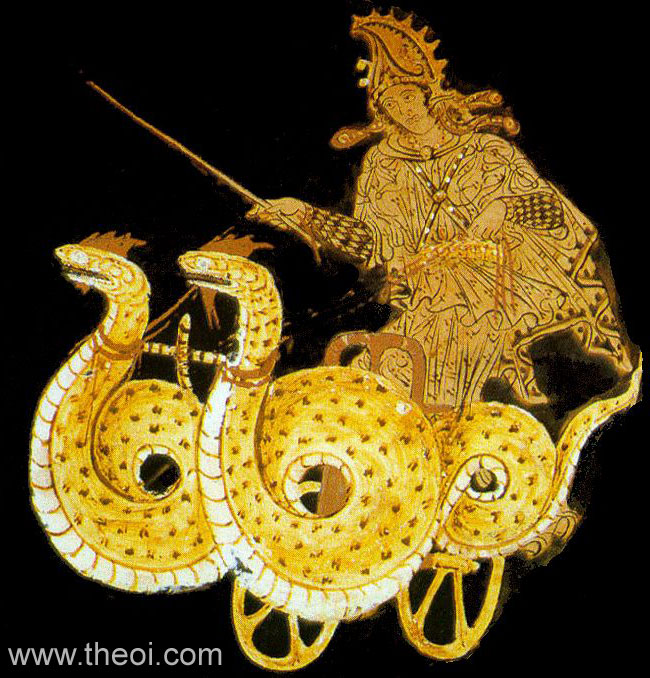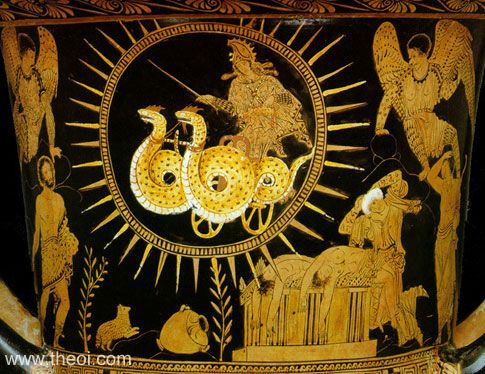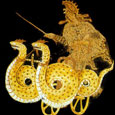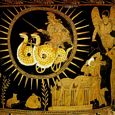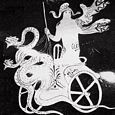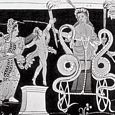DRAGONS OF MEDEA (Drakones) - Serpents of Greek Mythology (original) (raw)
Greek Mythology >> Bestiary >> Dragons >> Dragons of Medea (Drakones Medea)
Greek Name
Δρακονες Πτερωτοι
Transliteration
Drakones Pterôtoi
Roman Name
Dracones Rapuere
Translation
Winged Dragons
Dragon-chariot of Medea, Lucanian red-figure krater C4th B.C., Cleveland Museum of Art
THE DRAKONES OF MEDEA were a pair of serpents which drew the flying chariot of the witch Medea. She summoned them to carry her away from Korinthos (Corinth) following the murder of King Kreon (Creon), his daughter Glauke (Glauce) and her children by Iason (Jason).
PARENTS
Born of the blood of the TITANES (Other sources)
CLASSICAL LITERATURE QUOTES
Pseudo-Apollodorus, Bibliotheca 1. 146 (trans. Aldrich) (Greek mythographer C2nd A.D.) :
"Medeia [slew Kreon (Creon), Glauke (Glauce) and her sons by Iason (Jason)], and escaped to Athens on a chariot drawn by winged Drakones (Dragon-Serpents) which she had received from [her grandfather, the sun-god,] Helios."
Diodorus Siculus, Library of History 4. 50. 6 (trans. Oldfather) (Greek historian C1st B.C.) :
"She [Medea, posing as a priestess of Artemis,] declared [to King Pelias] that Artemis, riding through the air upon a chariot drawn by Drakones (Dragon-Serpents), had flown in the air over many parts of the inhabited earth and had chosen the realm of the most pious king in all the world for the establishment of her own worship and for honours which should be for ever and ever . . . By means of certain drugs, Medea caused shapes of Drakones to appear, which she declared had brought the goddess through the air from the Hyperboreans to make her stay with Pelias."
Pseudo-Hyginus, Fabulae 26 (trans. Grant) (Roman mythographer C2nd A.D.) :
"Medea, with her yoked Dracones (Dragon-Serpents), returned [from Athens] to Colchis."
Pseudo-Hyginus, Fabulae 27 :
"Medea had come there [to Colchis from Athens] in her chariot with the yoked Dracones (Dragon-Serpents)."
Dragon-chariot of Medea, Lucanian red-figure krater C4th B.C., Cleveland Museum of Art
Ovid, Metamorphoses 7. 217 (trans. Melville) (Roman epic C1st B.C. to C1st A.D.) :
"[Medea gathers ingredients for a spell of rejuvenation :] ‘By winged Dracones (Dragon-Serpents) drawn, my [Medea's] chariot here stands.’ And there the chariot stood, sent down from heaven her purpose to fulfil. She mounted, stroked the harnessed Dracones' necks, shook the light reins and soared into the sky, and gazing down beheld, far far below, Thessalian Tempe; then the Serpents' (Serpens') course she set for regions that she knew of old. The herbs that Pelion and Ossa bore, Othrys and Pindus and that loftiest peak, Olympus, she surveyed, and those that pleased some by the roots she culled, some with the curve of her bronze blade she cut; many she chose beside Apidanus' green banks and many beside Amphrysus; nor was swift Enipeus exempt; Peneus too and the bright stream of broad Spercheus and the reedy shores of Boebe gave their share, and from Anthedon she plucked the grass of life . . . And now nine days had seen her and nine nights roaming the world, driving her Dracon team. Then she returned; the Dracones, though untouched save by the wafting odour of those herbs [i.e. those had collected for the rejuvenation spell], yet sloughed their aged skins of many years."
Ovid, Metamorphoses 7. 350 & 391 ff :
"[Medea flees Thessalia (Thessaly) after the murder of King Pelias :] Had she [Medea] not soared away with her winged Serpents (Serpentes), she surely must have paid the price. Aloft, over the peak of shady Pelion . . . she fled, and over Othrys . . . [Until] at last, borne on her Vipers' (Vipereae) wings, she [Medea] reached Ephyra [Corinth], Pirene's town . . .
But when her witch's poison had consumed the new wife [i.e. Jason's bride Glauce], and the sea on either side had seen the royal palace all in flames, her wicked sword was drenched in her son's blood; and, winning thus a mother's vile revenge, she fled from Jason's sword. Her Dracon (Dragon-Serpent) team, the Dracones Titaniaci (Titan-Dragons), carried her away to Palladiae [the city of Athens]."
Seneca, Hercules Furens 1022 (trans. Miller) (Roman tragedy C1st A.D.) :
"[Medea has slain her children by Jason in Corinth.]
Medea : I am wont to flee. A way through the air has opened for me; two Serpents offer their scaly necks bending to the yoke . . . I through the air on my winged car shall ride.
Jason : Go on through the lofty spaces of high heaven and bear witness, where thou ridest, that there are no gods."
Valerius Flaccus, Argonautica 5. 452 (trans. Mozley) (Roman epic C1st A.D.) :
"[Medea] with Winged Serpents cleaves the air, dripping with murder [i.e. after slaying her sons by Jason]."
Valerius Flaccus, Argonautica 7. 120 :
"Circe was borne away [from the land of Colchis] by winged Dracones (Dragon-Serpents)."
ANCIENT GREEK & ROMAN ART
M26.1 Dragon-Chariot of Medea
Lucanian Red Figure Vase Painting C4th B.C.
M26.1B Medea, Dragons, Jason
Lucanian Red Figure Vase Painting C4th B.C.
M26.2 Dragon-Chariot of Medea
Apulian Red Figure Vase Painting C4th B.C.
O28.7 Dragon-Chariot of Medea
Apulian Red Figure Vase Painting C4th B.C.
SOURCES
GREEK
- Apollodorus, The Library - Greek Mythography C2nd A.D.
- Diodorus Siculus, The Library of History - Greek History C1st B.C.
ROMAN
- Hyginus, Fabulae - Latin Mythography C2nd A.D.
- Ovid, Metamorphoses - Latin Epic C1st B.C. - C1st A.D.
- Seneca, Medea - Latin Tragedy C1st A.D.
- Valerius Flaccus, The Argonautica - Latin Epic C1st A.D.
OTHER SOURCES
Other references not currently quoted here: Euripides Medea.
BIBLIOGRAPHY
A complete bibliography of the translations quoted on this page.
